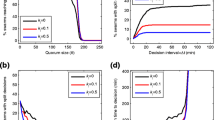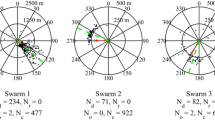Abstract
This study addresses a question about the nest-site selection process of honeybee swarms: how do the scout bees know when to initiate the preparation for their swarm’s move to their new home? We tested the quorum-sensing hypothesis: that the scouts do this by noting when one of the potential nest sites under consideration is being visited by a sufficiently large number of scouts. A falsifiable prediction of this hypothesis is that delaying the formation of a quorum of scout bees at a swarm’s chosen nest cavity, while leaving the rest of the decision-making process undisturbed, should delay the start of worker piping (the prepare-for-takeoff signal) and thus the takeoff of the swarm. In paired trials, we presented each of four swarms once with five nest boxes close to each other at a site and once with a single nest box. The multiple nest boxes caused the scouts visiting the site to be dispersed among five identical nest cavities rather than concentrated at one. We observed long delays in the start of piping and the start of takeoff in the five-nest-box trials relative to the one-nest-box trials. These results provide strong support for the quorum-sensing hypothesis.


Similar content being viewed by others
References
Chittka L, Dyer AG, Bock F, Dornhaus A (2003) Bees trade-off foraging speed for accuracy. Nature 424:388
Combs GF (1972) The engorgement of swarming worker honeybees. J Apic Res 11:121–128
Dyer FC (2000) Group movement and individual cognition: lessons from social insects. In: Boinski S, Garber PA (eds) On the move: how and why animals travel in groups. University of Chicago Press, Chicago, pp 127–164
Esch H (1967) The sounds produced by swarming honey bees. Z Vergl Physiol 56:408–411
Esch H (1976) Body temperature and flight performance of honey bees in a servomechanically controlled wind tunnel. J Comp Physiol 109:264–277
Esch H, Goller F, Heinrich B (1991) How do bees shiver? Naturwissenschaften 78:325–328
Franks NR, Pratt SC, Mallon EB, Britton NF, Sumpter DJT (2002) Information flow, opinion polling and collective intelligence in house-hunting social insects. Philos Trans R Soc Lond B 337:1567–1583
Franks NR, Dornhaus A, Fitzsimmons JP, Stevens M (2003) Speed versus accuracy in collective decision making. Proc R Soc Lond B 270:2457–2463
Heinrich B (1979) Thermoregulation of African and European honeybees during foraging, attack, and hive exits and returns. J Exp Biol 80:217–229
Heinrich B (1981) The mechanisms and energetics of honeybee swarm temperature regulation. J Exp Biol 91:25–55
Lindauer M (1955) Schwarmbienen auf Wohnungssuche. Z Vergl Physiol 37:263–324
Lindauer M (1971) Communication among social bees. Harvard University Press, Cambridge, Mass.
Mallon EB, Pratt SC, Franks NR (2001) Individual and collective decision-making during nest site selection by the ant Leptothorax albipennis. Behav Ecol Sociobiol 50:352–359
Martin P (1963) Die Steuerung der Volksteilung beim Schwärmen der Bienen. Zugleich ein Beitrag zum Problem der Wanderschwärme. Insectes Soc 10:13–42
Mitchell C (1970) Weights of workers and drones. Am Bee J 110:468–469
Osman A, Lou LG, Muller-Gethman H, Rinkenauer G, Mattes S, Ulrich R (2000) Mechanisms of speed–accuracy trade-off: evidence from covert motor processes. Biol Psychol 51:173–199
Pratt SC, Mallon EB, Sumpter DJT, Franks NR (2002) Quorum sensing, recruitment, and collective decision-making during colony emigration by the ant Leptothorax albipennis. Behav Ecol Sociobiol 52:117–127
Schneider SS, Lewis LA (2004) The vibrational signal, modulatory communication and organization of labor in honey bees, Apis mellifera. Apidologie 35:117–131
Seeley TD (1977) Measurement of nest cavity volume by the honeybee (Apis mellifera). Behav Ecol Sociobiol 2:201–227
Seeley TD, Buhrman SC (1999) Group decision making in swarms of honey bees. Behav Ecol Sociobiol 45:19–31
Seeley TD, Buhrman SC (2001) Nest-site selection in honey bees: how well do swarms implement the “best-of-N” decision rule? Behav Ecol Sociobiol 49:416–427
Seeley TD, Tautz J (2001) Worker piping in honey bee swarms and its role in preparing for liftoff. J Comp Physiol A 187:667–676
Seeley TD, Visscher PK (2003) Choosing a home: how the scouts in a honey bee swarm perceive the completion of their group decision making. Behav Ecol Sociobiol 54:511–520
Seeley TD, Visscher PK (2004) Group decision making in nest-site selection by honey bees. Apidologie 35:1–16
Seeley TD, Morse RA, Visscher PK (1979) The natural history of the flight of honey bee swarms. Psyche 86:103–113
Seeley TD, Kleinhenz M, Bujok B, Tautz J (2003) Thorough warm-up before take-off in honey bee swarms. Naturwissenschaften 90:256–260
Visscher PK, Camazine S (1999) The mystery of swarming honeybees: from individual behaviors to collective decisions. In: Detrain C, Deneubourg J-L, Pasteels JM (eds) Information processing in social insects. Birkhäuser, Basel, pp 355–378
Weidenmüller A, Seeley TD (1999) Imprecision in waggle dances of the honeybee (Apis mellifera) for nearby food sources: error or adaptation? Behav Ecol Sociobiol 46:190–199
Acknowledgements
The research reported here was supported by the U.S. National Science Foundation (grant no. IBN02-10541). We are deeply grateful to Adrian Reich for his constant good cheer while counting scout bees at the nest boxes and waggle runs at the video monitor, and to Dr. James G. Morin, director of the Shoals Marine Laboratory, for providing space and facilities on Appledore Island. This is contribution no. 117 of the Shoals Marine Laboratory.
Author information
Authors and Affiliations
Corresponding author
Additional information
Communicated by M. Giurfa
Rights and permissions
About this article
Cite this article
Seeley, T.D., Visscher, P.K. Quorum sensing during nest-site selection by honeybee swarms. Behav Ecol Sociobiol 56, 594–601 (2004). https://doi.org/10.1007/s00265-004-0814-5
Received:
Revised:
Accepted:
Published:
Issue Date:
DOI: https://doi.org/10.1007/s00265-004-0814-5




